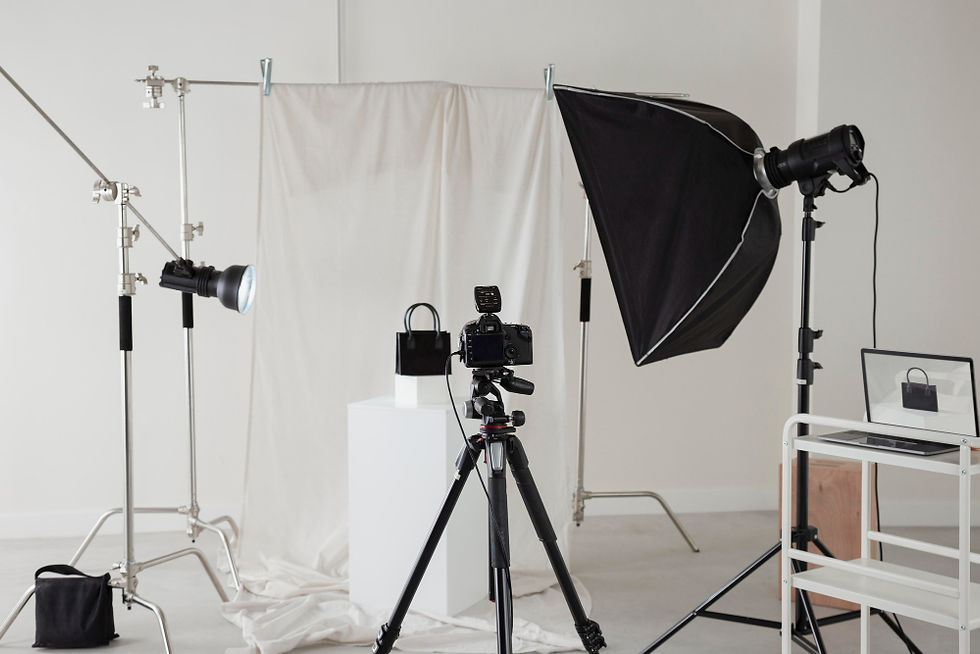Why Is White Background the Standard for Jewelry Photography?
- EtherArts Photography
- Aug 28
- 3 min read

In the world of online retail, first impressions matter. A customer can’t touch, feel, or try on jewelry before buying. It’s the photo that does all the selling. That’s why white background jewelry photography has become the gold standard for e-commerce platforms, jewelry stores, and marketplaces like Amazon, Etsy, and Shopify. A clean white backdrop isn’t just about aesthetics; it’s a powerful tool that influences customer trust, buying decisions, and brand perception.
The Power of Simplicity
White backgrounds remove distractions. When you’re selling something as intricate as a diamond ring or as delicate as a gold pendant, the last thing you want is for the backdrop to steal attention. A plain white setting ensures the jewelry remains the star of the shot. Every sparkle, texture, and curve is highlighted, making it easier for the customer to focus on what they’re actually considering buying.
This simplicity isn’t just visual. It creates clarity. A white background signals professionalism, consistency, and quality, all of which are essential for building trust online.
Meeting Marketplace Standards
Another major reason white backgrounds dominate jewelry photography is compliance. Most large e-commerce platforms have strict photo guidelines, and a pure white background is often non-negotiable. For instance, Amazon requires product photos to be shot against a white background to maintain uniformity across millions of listings.
For jewelry sellers, following these standards isn’t just about ticking a box. It’s about making sure their products appear credible alongside competitors. A ring on a colored or textured background might look artistic, but it risks being rejected on certain platforms or, worse, ignored by buyers trained to trust the clean look of white.
White Means Versatility
Think about all the different places a jewelry photo needs to live: websites, social media, catalogs, email campaigns, and sometimes even print ads. A white background gives you flexibility. You can crop, resize, or repurpose images without clashing with other design elements.
If your website has a minimal layout, white jewelry shots blend seamlessly. If your Instagram grid is colorful, white product shots balance the palette. In short, a white background is a universal canvas that adapts to any marketing channel.
Highlighting Details That Matter
Jewelry is all about the details: the sparkle of a diamond, the polish of silver, the craftsmanship in a chain. A cluttered or dark background can drown out these subtleties. White, on the other hand, acts like a spotlight.
With the right lighting, a white backdrop enhances reflections and ensures gemstones shine without looking artificial. Customers can see the piece more clearly, which reduces uncertainty and increases the likelihood of purchase. For jewelry priced at hundreds or thousands of dollars, clear and accurate representation is everything.
Psychological Impact on Buyers
There’s also a psychological layer. White is often associated with purity, luxury, and modernity. A crisp white photo feels clean, professional, and high-end—exactly the qualities customers want in fine jewelry.
Studies on consumer behavior show that simple visuals help buyers process information more quickly. When a shopper scrolls through dozens of options online, a white background ensures your jewelry communicates instantly without mental clutter. That split-second advantage can be the difference between a click and a scroll-past.
Cost-Effectiveness and Workflow
From a practical standpoint, shooting jewelry on a white background is efficient. It’s easier to achieve consistency across an entire collection, especially when photographing hundreds of pieces. Post-production editing, like background cleanup and color correction, is also simpler and faster on white.
This efficiency saves money in the long run, something small businesses and large retailers alike appreciate.
When White Isn’t the Whole Story
Of course, this doesn’t mean white is the only way to showcase jewelry. Lifestyle shots such as rings on a hand, necklaces draped over fabric, or earrings styled with an outfit help buyers imagine how pieces fit into their lives. These images build emotion and storytelling.
But here’s the key: lifestyle shots complement, not replace, white background images. The white-background standard ensures consistency and compliance, while lifestyle shots provide personality and brand identity. Successful jewelry sellers typically use both strategically.
Final Thoughts
White backgrounds aren’t just a photography trend. They’re a proven standard rooted in psychology, marketing, and practical business needs. They highlight the jewelry, meet platform requirements, create consistency, and give customers the clarity they need to buy with confidence.
If you’re in the jewelry business, investing in professional white background photos isn’t optional. It’s essential. They are the backbone of your digital storefront, and in a crowded online market, they can be the difference between blending in and standing out.
.png)


Comments